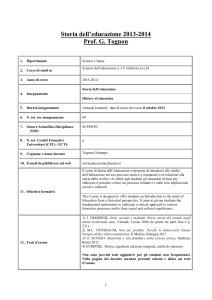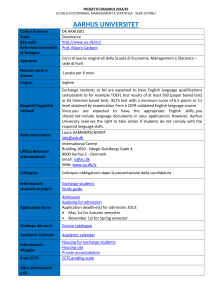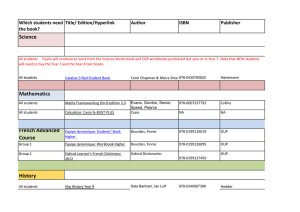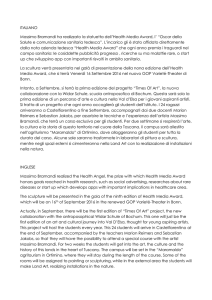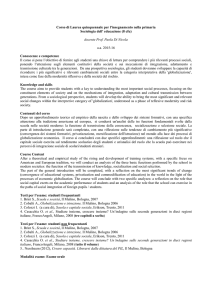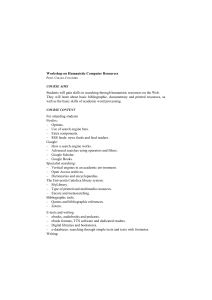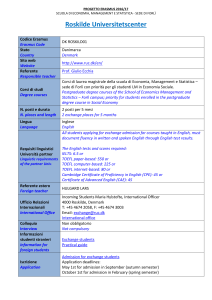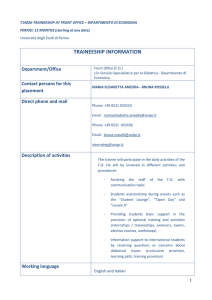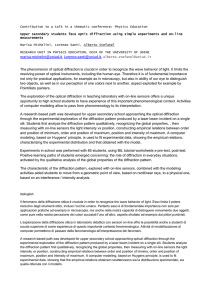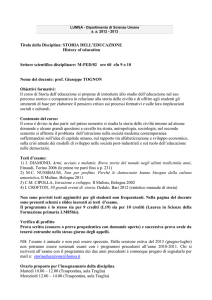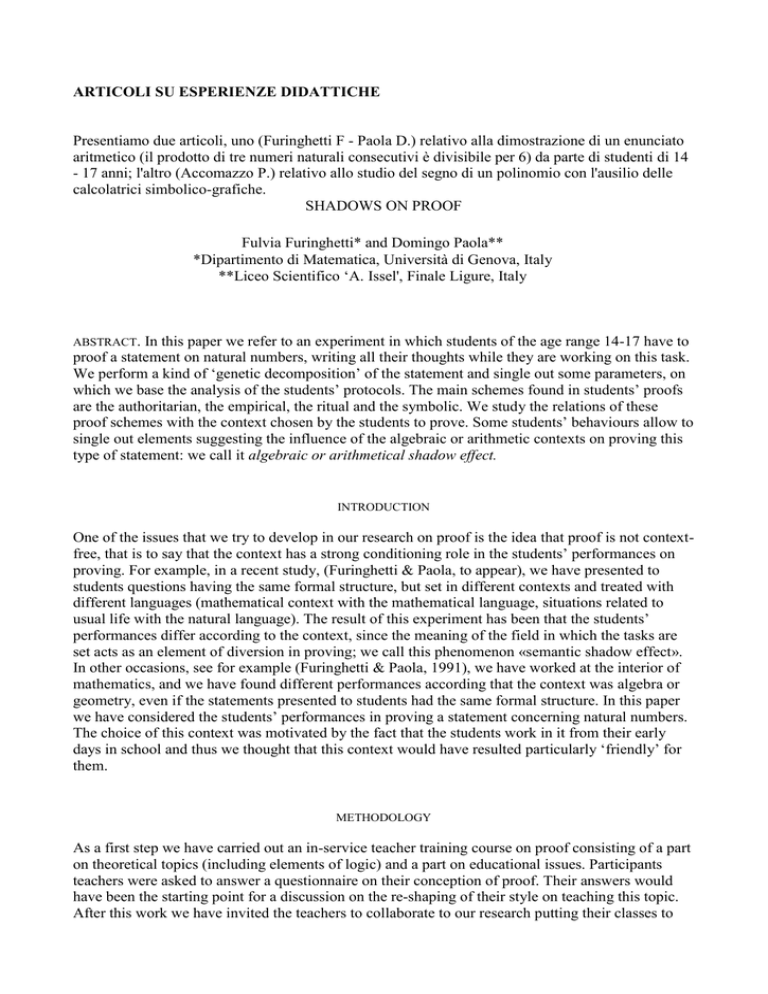
ARTICOLI SU ESPERIENZE DIDATTICHE
Presentiamo due articoli, uno (Furinghetti F - Paola D.) relativo alla dimostrazione di un enunciato
aritmetico (il prodotto di tre numeri naturali consecutivi è divisibile per 6) da parte di studenti di 14
- 17 anni; l'altro (Accomazzo P.) relativo allo studio del segno di un polinomio con l'ausilio delle
calcolatrici simbolico-grafiche.
SHADOWS ON PROOF
Fulvia Furinghetti* and Domingo Paola**
*Dipartimento di Matematica, Università di Genova, Italy
**Liceo Scientifico ‘A. Issel', Finale Ligure, Italy
ABSTRACT.
In this paper we refer to an experiment in which students of the age range 14-17 have to
proof a statement on natural numbers, writing all their thoughts while they are working on this task.
We perform a kind of ‘genetic decomposition’ of the statement and single out some parameters, on
which we base the analysis of the students’ protocols. The main schemes found in students’ proofs
are the authoritarian, the empirical, the ritual and the symbolic. We study the relations of these
proof schemes with the context chosen by the students to prove. Some students’ behaviours allow to
single out elements suggesting the influence of the algebraic or arithmetic contexts on proving this
type of statement: we call it algebraic or arithmetical shadow effect.
INTRODUCTION
One of the issues that we try to develop in our research on proof is the idea that proof is not contextfree, that is to say that the context has a strong conditioning role in the students’ performances on
proving. For example, in a recent study, (Furinghetti & Paola, to appear), we have presented to
students questions having the same formal structure, but set in different contexts and treated with
different languages (mathematical context with the mathematical language, situations related to
usual life with the natural language). The result of this experiment has been that the students’
performances differ according to the context, since the meaning of the field in which the tasks are
set acts as an element of diversion in proving; we call this phenomenon «semantic shadow effect».
In other occasions, see for example (Furinghetti & Paola, 1991), we have worked at the interior of
mathematics, and we have found different performances according that the context was algebra or
geometry, even if the statements presented to students had the same formal structure. In this paper
we have considered the students’ performances in proving a statement concerning natural numbers.
The choice of this context was motivated by the fact that the students work in it from their early
days in school and thus we thought that this context would have resulted particularly ‘friendly’ for
them.
METHODOLOGY
As a first step we have carried out an in-service teacher training course on proof consisting of a part
on theoretical topics (including elements of logic) and a part on educational issues. Participants
teachers were asked to answer a questionnaire on their conception of proof. Their answers would
have been the starting point for a discussion on the re-shaping of their style on teaching this topic.
After this work we have invited the teachers to collaborate to our research putting their classes to
our disposal. Three teachers have agreed; the fact that they were aware of the educational problems
underlying proof and that they were motivated by the previous activities makes us confident that
they would have observed the instructions we gave. We were lucky since the three teachers teach in
four classes which differs for the ages of students (Teacher A: one class of students aged 14,
Teacher B: one class of students aged 15, Teacher C: one class of students aged 16 and one 17) and
for the types of curricula (with more or with less emphasis on mathematics).
The study consisted in analysing how the students solve the following exercise: «Prove that the
product of any three consecutive natural numbers is divisible by 6». Students were asked to write
all their attempts and thoughts. Our analysis has been performed on their protocols.
The instructions to the teachers were:
- to report the time emploied
- to not help or influence the students
- to push them to write all the things they were thinking in solving the exercise
- to make students aware of which project they were part and to encourage them to an active
collaboration with the researchers; this awareness of students was promoted also to prevent them
from being lazy or cheating the teacher by cribbing from a school-mate, since this would have
polluted the experiment.
We succeeded quite completely in all these points. We have also asked to the teachers to make a
prevision on the students performances. All the teachers agreed that the exercise was within the
capacity of their students and no one considered that it would be difficult to deal with the technical
issues of the exercise such as the interpretation of the terms involved in the statement (natural,
divisible, consecutive). In the following we give some brief information.
Teacher A. His students (class A) are aged 14. The school where he teaches has a strong
mathematical curriculum; in algebra, among other topics, he develops modular arithmetics with the
remainders classes. He feels that his good students will be able to prove the statement through the
remainders classes. He does not takes into consideration the exploration through less formal ways.
Teacher B. Her students (class B) are aged 15. The school where she teaches is oriented to give a
good mastery of foreign languages; the mathematics program is in line with the recent curriculum
changes in Italy, but mathematics is not an important subject. She thinks that her students will start
with examples and afterwards will generalize. Many students will look for some formulas. The
greatest difficulty will be to formalize the intuition in a logically correct sequence of statements.
She feels that some students will make many examples with the aim of finding counterexamples
which prove that the product of any three consecutive natural numbers is not divisible by 6.
Teacher C. Her students are aged 16 (class C I) and 17 (class C II). The school where she teaches is
aimed at preparing the students in economical disciplines. The mathematics programs is rather
innovative; the students learn also to program at the computer in the mathematics course. She thinks
that few students will work on numerical examples; the majority will look for a formalization and
will attempt to manipulate the expressions (n - 1)n(n + 1) or n(n + 1)(n + 2). Some students will
argument in a quite descriptive way.
ANALYSIS OF THE RESULTS
To analyse the protocols we put us in a perspective similar to that of the ‘genetic decomposition’
presented in (Dubinsky, 1991), that is to say we analyse the exercise proposed to students in order
to isolate its main conceptual or procedural components and the relations among them. As a result
we have single out the following parameters which we shall use as a basis for studying the
protocols.
• algebraic language (even if in a poor form) is used or is not used
• which kind of use of algebra is prevailing, in particular how the letters are used
• mastery of the concepts specific to the problem (divisibility, multiples)
• role of numerical examples
• algebraic or analgebraic thinking, with particular reference to the interpretation of algebraic
expressions
• use of some kind of iconic language
• use of quantifiers
• proof schemes followed by students
We observe that some parameters mainly concerns algebra, others are more specific of the process
of proof, even if we shall see that the distinction is not so clean. At the interior of algebra we
distinguish between pure manipulative issues and issues linked to the mastery of critical concepts,
such as variables and quantifiers.
According to this classification we have singled out general factors concerning all the classes A, B,
C I and C II pointing out differences and analogies. Afterwards we have analysed more in details
the behaviours of the class C II to have more precise elements.
The type of the present research does not imply a quantitative analysis of the numerical data; we
only give some general figures which provide a first overview of the situation.
A
Students’ Students Algebraic
Natural
age
answering language language
14
19 of 19
10
12
Iconic
language
0
7
Maths
program
strong
B
15
11 of 16
11
1
0
0
weak
C I*
16
24 of 24
7
17
0
6
medium
C II
17
18 of 18
6
13
0
2
medium
Classes
Right
answers
To make clear the figures in the table we note that:
- The sum of the numbers of the students who use algebra or not is in general greater that the
number of the answering students since some student use both the languages adopting a sort of
syncopated-like language.
- The data of the class C I have a meaning different from that of the others: the teacher has made a
mistake in giving the text of the exercise, putting the number 2 instead of 3, so that the text has
became «Prove that the product of any two consecutive natural numbers is divisible by 6», which is
an impossible task. We shall see that also in this case interesting behaviours emerged.
Not in all the classes to solve the exercise was a compulsory task, nevertheless the third column of
the table shows that students participate with good will; this fact is confirmed by the care employed
in working on the exercise.
One of the characteristics of this exercise is that it can be easily developed through the natural
language by activating the frame of divisibility or of multiples. On the contrary, if the statement is
translated into an algebraic expression, the attempts of manipulation may bring to a cul de sac. For
this reason we have taken as a first parameter to consider the use or non use of the algebraic
language. In the classes A and B the literal computation is a topic of the program; in particular in
the class B the teacher focus on it (this is a quite common behaviour in the Italian tradition). The
students of the classes C I and C II have left the study of algebra (literal computation and so on)
since one or two years respectively. It is likely that the relatively high percentage of right answers in
the class A is due to the fact that here the classes of remainders are part of the program developed:
the protocols show that students understand the text and are able to activate a frame suitable to
solve the problem.
In the class B all the students use the algebraic language. No one in the class B produces right
answers. The protocols show that there is a lack of control in algebra which provokes a loss of
control in proving. The students of class B are also victims of what in (Furinghetti & Paola, 1991) is
called «irresistible impulse to calculate», that is to say they transform literal expressions and solve
equations without any precise purpose linked to the task. The proof scheme adopted, according to
the classification in (Harel & Sowder, 1996a and b), is the ritual, since from the analysis of the
protocols it emerges that students think that the justification has to be communicated via symbolic
expressions or computations. In this case the ritual is combined with the symbolic proof scheme,
since symbols are used «as if they possess a life of their own without reference to their possible
functional or quantitative relations to the situation» (Harel & Sowder, 1996a, p.61).
In the cases A and B it is not clear how much the students’ behaviours are induced also by the
authoritarian scheme. According to (ibidem, p.60) this scheme is present when « students are not
concerned with the question of the burden of proof, and their main source of conviction is a
statement given in a textbook, uttered by a teacher, or offered by a knowledgeable classmate». This
scheme has been clearly evidenced in the class C I, thanks to the mistake made by the teacher in
giving the text of the problem (see above). We are aware that the form of the text of the exercise
«Prove that ...» was more commanding than the form «Is the product of two consecutive natural
numbers divisible by 6?», thus it strongly pushes students towards the acceptation of the statement
as surely true. Nevertheless the weight of the authoritarian scheme in conditioning the students
behaviour is evident since among the 13 students who find counterexamples only 6 recognize that
the statement proposed by the teacher is not true, while 7 try to forget it. In these last students the
authoritarian proof scheme prevails on evidence. A confirmation of the fact that the authoritarian
scheme conditions the students’ performances is provided by Sara. She produces 6 examples which
satisfies the statement and writes «The product of two numbers must [emphasis is our] give a
multiple of 6». In this case the presence of the authoritarian scheme is unaware, in other cases is
aware. For example, Alessandra writes: «- Natural numbers are the positive numbers. - Consecutive
means one after the other. - The product is the result of a multiplication. Then I must prove that the
result of the multiplication of two numbers, for example 3 and 4, is divisible by 6. ...I have
understood the statement, but I'm not able to prove it». The analysis of the given statement
performed by expressing the definition of the terms intervening in it with her own words is due to
the doubt on the possibility to solve problem.
We can label this students’ behaviour in class C I as the schizophrenia caused by the acceptation of
the existence of two separate worlds - the world of the teacher and their own world - which have not
necessarily points of contacts or at least analogies.
As we have observed in the case of the wrong text, also in the case of the right text the form of the
exercise («Prove ...» instead of «Is ...?») pushes students towards argumentation rather than
conjecturing; this fact conditions the way they worked. Nevertheless we were expecting from the
protocols to find some forms of iconic representation: in all the classes no one has used it. We are
referring to the representation of the numerical rule, to the use of numbers patterns as in the primary
school, to arrows for connecting formulas, to tables for connecting the various examples and so on
... Our findings are in accordance with some aspects emphasized in educational research (Healy &
Hoyles, 1996; Presmeg & Bergsten, 1995). This avoidance of the graphical language could be
linked to the premature use of the algebraic language and of the formalization. This hypothesis
comes from the results in (Dutto, 1996), where we find that students aged 11-13 use different iconic
representations, when solving our problem and others similar.
ZOOM ON THE RESULTS OF THE CLASS C II
This class seems a good set for general considerations. While in the other classes the role of algebra
(especially literal computation) could have been too much conditioning since it is the main part of
the program, here students have left the study of algebra (literal computation and so on) since two
years. Nevertheless they are working in topics (functions, programming with computer) which can
add motivations to the algebra they have done before. For example, they have had the occasion to
consider the concept of variable from different points of view. From the analysis of the protocols
some facts emerge that we outline in the following.
• As observed in (Bloedy-Vinner, 1994; Furinghetti & Paola, 1994) one of the main problems in
algebra concerns the use of quantifiers. For example, Erik writes the formula 6n = n(n + 1)(n + 2),
ascribing the same status to the letter n on the left and on the right of the sign =. Here there is a lack
of command in using the quantifiers: the student ignores that the right formulation would be «For
any natural number n a natural number k exists such that n(n + 1)(n + 2) = 6k».
• We have found an empirical proof scheme, see (Harel & Sowder, 1996), based on the use of
examples and confined to a level of pre-generalization. Myriam verifies the statement in a single
case and writes «It works! ... But it could be by chance. Perhaps I have to try again with 5 or 6
numbers». In some cases the stage of pre-generalization is really naïve: for example, Maura checks
the property expressed in the statement through ‘little’ numbers (3, 4, 5) and through ‘big’ numbers
(1001, 1002, 1003), ascribing a property of generalization to these last ones.
The empirical proof scheme is present only when the natural language is used. The students who
start writing the expression n(n + 1)(n + 2) do not produce examples. This fact suggests that, as it
was observed in (Bloedy-Vinner, 1995), they do not interpret this expression as a function
producing numerical values. This explains why we do not find the empirical proof scheme in
protocols where the algebraic language is used. In some cases the examples simply lead to
paraphrase the given statement.
• The use of letters is not necessarily evidence of an algebraic mode of thinking: in some cases we
observe that letters are used as mere labels. For example, Silvia writes «1 . 2 . 3 /6 = 6/6 = 1» and
just after «a(a + 1)(a + 2)/(a + 5)» to indicate that the product of three consecutive natural numbers
is divisible for 6: clearly here a is a label for the value 1. On the contrary Matteo (one of the two
good solvers), after having proved the statement, writes the expression
9 3 10 5 11
3 5 11
1 2 3
It seems that he uses the number in more general terms than the Silvia does with letters.
• There are only two students who solve rightly (Matteo and Mario). Matteo proves using the
natural language, by activating the frame of divisibility evoked with the sentence «In the product of
three consecutive natural numbers one is always divisible for 2, one for 3 and one for 1». He uses
the formula n(n + 1)(n + 2) only for synthesizing the thesis and afterwards he gives the example
quoted above which seems to have a didactic function. Mario uses five examples for exploring the
situation presented in the given statement and after it grasps that «Given three consecutive natural
numbers one is even and one is divisible by three». At this point he gives his proof and after verifies
the truth of the statement on an example which has a didactic purpose. The fact that in both the
cases the examples are given after the proof with a didactic function suggests that the students
consider examples as a privileged means for communicating.
• In spite of the teacher’s expectation (see the chapter Methodology) not all the students showed a
sufficient command on the terms appearing in the given statement. The bête noire was the word
«divisible», some problems were given also by the zero (if it has to be considered belonging to
natural numbers) and to the nature of natural numbers (are the negative integers natural numbers?).
This makes our initial hypothesis on the property of natural numbers to be a friendly context too
much optimistic.
The comparison of the expectations expressed by the three teachers and our findings would be an
interesting starting point for discussing the didactic contract. For example, the students considered
good by the teacher C used algebraic formalism and were not able to answer.
CONCLUSIONS
In all the classes the simple problem from which we started revealed itself a Pandora’s vase of
issues on students’ behaviours both in proving and in doing algebra.
As for proof the most adopted is the empirical proof scheme. It is our opinion that this fact is
strongly dependent on the arithmetic context. We have also observed the presence of ritual,
symbolic and authoritarian proof schemes in students who used the algebraic language. The
authoritarian proof scheme seems to be induced by the kind of didactic contract between the teacher
and the students. The ritual and the symbolic seem more related to the specificity of the algebraic
context that the students have chosen. We feel that algebra may hide the necessity to be convinced
and students are strongly pushed towards the ritual scheme. The perception that they have of
algebra as a meaningless domain of symbols confirms their conviction that only a symbolic way is
what the teachers is expecting from them.
The orientation towards formalism has not as a counterpart a good command in dealing with the
tools of algebra. We have observed the poor use of quantifiers, but also of other basic tools such as
variables (or parameters): the letters are often used only as stenographic signs.
Our exercise shows a double shadow effect on proof. From one hand we observe an algebraic
shadow effect on the meaning that some students would have from arithmetic which prevents from
using it in their attempts of proving. On the other hand there is also an arithmetical shadow effect
which confine students to the empirical proof scheme and prevent them from generalizing.
REFERENCES
Bloedy-Vinner, H.: 1994, ‘The analgebraic mode of thinking - The case of parameter’, in J. P. Ponte
& J. F. Matos (eds), Proceedings of PME XVIII (Lisboa), v.II, 88-95.
Bloedy-Vinner, H.: 1995, ‘Analgebraic interpretation of algebraic expressions: functions or
predicates?’, in L. Meira & D. Carraher (eds), Proceedings of PME 19 (Recife), v.2, 42-49.
Dubinski, E.: 1991, ‘Reflective abstraction in advanced mathematical thinking’, in D. O. Tall (ed.),
Advanced mathematical thinking, Kluwer, Dordrecht-Boston-London, 95-123.
Dutto, V.: 1996, Questioni tecniche e problemi di sperimentazione didattica per lo sviluppo
dell’argomentazione matematica e l’approccio alla dimostrazione nella scuola media, Tesi di
Laurea, Dipartimento di Matematica dell’Università di Genova.
Furinghetti, F. & Paola, D.: 1991, ‘On some obstacles in understanding mathematical texts’, in F.
Furinghetti (ed.), Proceedings of the PME XV (Assisi), v.2, 56-63.
Furinghetti, F. & Paola, D.: 1994, ‘Parameters, unknowns and variables: a little difference?’, in
Ponte & J. F. Matos (eds), Proceedings of PME XVIII (Lisboa), v.II, 368-375.
Furinghetti, F. & Paola, D.: to appear, ‘Presentation of a questionnaire for evaluating the influence
of the semantic field in mathematical proof’, Proceedings of the T G 8 at ICME 8 (Sevilla,
1996).
Harel, G. & Sowder, L.: 1996a, ‘Classifying processes of proving’, in A. Gutierrez & L. Puig (eds),
Proceedings of PME 20 (Valencia), v.3, 59-65.
Harel, G. & Sowder, L.: 1996b, Students’ proof schemes, Manuscript.
Healy, L. & Hoyles, C.: 1996, ‘Seeing, doing and expressing: an evaluation of task sequences for
supporting algebraic thinking’, in A. Gutierrez & L. Puig (eds), Proceedings of PME 20
(Valencia), v.3, 67-74.
Presmeg, N. C. & Bergsten, C.: 1995, ‘Preference for visual methods: an international study’, in L.
Meira & D. Carraher (eds), Proceedings of PME 19 (Recife), v.3, 58-65.
Segno di un polinomio ; uso di tabelle comparative nello studio di disequazioni 1
Lo studio delle disequazioni di grado superiore al primo con la tabella dei segni dei fattori genera
talvolta incomprensioni : non è sempre chiara agli allievi la distinzione fra lo studio analitico del
segno dei singoli fattori e la comparazione successiva da cui nasce la risposta alla domanda che la
disequazione pone .
Allo stesso modo, nella soluzione di un sistema di disequazioni, alcuni allievi confondono la
tabella di intersezione (vero/falso) con la tabella dei segni (+/-).
Ho provato a ricomporre disequazioni di grado superiore al 1° con la Ti92. L’esperienza è
avvenuta in una classe seconda di Liceo scientifico con sperimentazione PNI di 27 allievi ;
avevamo a disposizione 16 calcolatrici ed il view screen.
I ragazzi sapevano risolvere disequazioni di primo grado ; avevano dimestichezza con le due
forme canoniche ax >b e ax + b > 0.
Partendo da quest’ultima abbiamo tabulato i segni di alcune funzioni di primo grado,
sign (12x) e sign (x4) . Abbiamo ricomposto quindi un polinomio di 2° grado con il
prodotto dei due precedenti e ne abbiamo studiato il segno : sign ( (12x) (x4))
fig. 2
fig. 3
Si ottiene una vera e propria tabella dei segni ; da notare le situazioni di non decisione in
corrispondenza degli zeri dei polinomi componenti ( sign(... ) ).
Abbiamo scorso i dati, osservando il legame tra il segno del prodotto ed i segni dei singoli fattori ;
gli studenti hanno riportato la tabella sul quaderno nella tradizionale forma di tabella dei segni.
Hanno però distinto, con colori diversi
la colonna che indica i valori di x
le colonne che analizzano i segni dei fattori
la colonna del risultato.
Successivamente ho dato loro da studiare, sempre con lo stesso metodo, il segno del polinomio
2x3+x23x ; ho chiesto quindi di ricavare i valori di x per i quali 2x3+x23x <0.
Analogamente, per studiare un sistema di disequazioni ci si è avvalsi di una tabella in cui si
y1 3x 2 0
chiedeva di tabulate i valori di verità/falsità di tre proposizioni aperte : y 2 1 x 0
y3 3x 4 0
(vedere fig. 3)
Gli allievi hanno osservato che in questo caso, per individuare i capisaldi, occorreva scegliere un
adeguato passo di incremento della x ; hanno inoltre sottolineato che, per poter trarre conclusioni
1
Pierangela Accomazzo, Liceo Scientifico "A. Einstein" - Torino
da questa tabella, occorre conoscere a priori il numero di intervalli significativi e la loro posizione
sull’asse reale.
Anche in questo caso è stata costruita sul quaderno la corrispondente tabella di intersezione di
insiemi.
In sintesi : con il metodo delle tabulazioni si possono risolvere disequazioni e sistemi di
disequazioni, a patto di ‘saper cercare’ le soluzioni, individuando in precedenza quali valori di x è
opportuno visualizzare sullo schermo. Se si lavora con disequazioni frazionarie, bisogna analizzare
in precedenza le situazioni che la Ti92 non risolve (zeri, casi in cui l’espressione perde di
significato).
Chiudi e ritorna al documento iniziale

